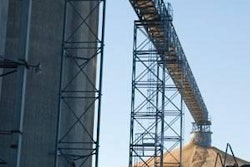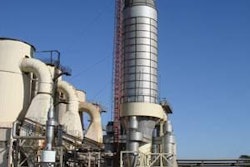
Bran, rice bran, parboiled rice bran, raw bran, stabilized rice bran. All of these terms are somewhat germane to the feed industry. However, there may be only one description that encompasses the true nutritional value of rice bran and that term is "stabilized rice bran." In this article, I will explain why, in my opinion, stabilized rice bran should be utilized over other forms that exist in the U.S. feed market today. Additionally, I will focus on the current trends in equine nutrition and how stabilized rice bran, as an ingredient technology, may provide a solution to overall digestive health and daily performance.
There are an inherent challenge that exists with retaining the nutritional value of rice bran and the germ layer when they are stripped off during the traditional rice milling process. The milling process leaves the rice bran subject to its own demise; specifically, the powerful lipase enzyme that resides in the bran layer may damage the overall nutritional value and shelf life of rice bran if its potential is not stopped immediately after milling. However, if lipase is successfully stopped, the end-product is a stable form of rice bran, stabilized rice bran, which at a rapid pace is being formulated in equine, pet and food animal nutrition diets.
Over 60 million tons of rice is produced on an annual basis around the world. The rice bran and germ layer represent 8 percent of the entire kernel weight, which can produce almost 5 million tons post-milling. Though the bran and germ layer (present definition of "rice bran") is only 8 percent by weight, rice bran as a whole contains over 60 percent of the nutrition in the entire kernel of rice. During the milling process, the bran and germ layer are rubbed off and come into contact with one another, subsequently exposing the naturally occurring poly- and mono-unsaturated plant-based fats in the bran layer to the potent lipase enzyme in the germ layer. The lipase (hydrolytic enzymes) immediately starts to hydrolyze the glycerides contained in the fat and creates an end product of free fatty acids and glycerol. Simply put, this process can render the rice bran rancid within hours post-milling, and as seasoned participants in the feed industry may know, rancid rice bran is not beneficial for use in any animal feed formulation, especially in equine and pet, or overall in companion animal diets.
Various attempts at stabilization have been made over the past 20 years; however most have been unsuccessful at protecting natural plant fats against the lipase enzyme. These various attempts, either through chemical or heat-based processes, result in end products that are not fully stabilized and deliver far less of the nutritional factors that naturally exist in rice bran. The only process I believe to be available in the world today that delivers a consistent, highly nutritious and truly stable form of rice bran is operated by The NutraCea Company. NutraCea operates a proprietary stabilization process that fully locks down or completely deactivates the powerful lipase enzyme, while simultaneously unlocking the rich, naturally occurring nutrition that exists in rice bran.
NutraCea rancidity study
NutraCea's proprietary rice bran stabilization technology is a non-chemical process designed to deactivate lipase enzymes and maintain hydrolytic stability, thus preventing rancidity, prolonging shelf life and maintaining the nutritional value of the stabilized rice bran.
NutraCea conducted an internal study in the fall of 2006 in order to track the development of rancidity of raw rice bran. The study was conducted in two of the primary rice growing regions of the country, the Mississippi delta and California. The study focused on the development of free fatty acids (FFAs) because the prevalence of FFAs is an excellent indicator of the development of hydrolytic instability. When the fat in rice bran comes into contact with lipase, the enzyme activates and hydrolyzes the glycerides of the fat to FFAs and glycerol. The rise in FFAs results in rancid or "organoleptically" unacceptable end-product, which, if consumed, can create detrimental animal health issues. Most food industry specialists consider FFAs that exceed 5 percent to be unusable for human consumption, and are also beyond the scope of "stabilized rice bran" which the AAFCO has identified as that having 4 percent or less FFAs.
Aside from having the proper engineering technology to stabilize raw rice bran, the NutraCea study also demonstrated how the improper handling of raw bran can cause hydrolysis, which rapidly turns the bran into a concrete state of rancidity. Most bran produced today is treated as a byproduct: after post-milling it is placed into bulk bin or flat bay storage for days-to-weeks and may be exposed to heat and relative humidity. Handling, heat and humidity all contribute to accelerating lipase activity on the raw bran and once the bran is rancid (in some cases within a matter of hours), it is permanent (and cannot be reversed with extrusion stabilization).
To demonstrate the importance of how handling bran may prevent it from exposure to potential rancid-causing elements, NutraCea representatives collected five-pound samples of raw rice bran directly from the rice bran polishing equipment at five rice mills: three were located in California and two were located in Louisiana. All samples were marked by their collection time, date and location of the rice mill from which the sample came. Each sample was subdivided into a one-pound and four-pound sample. The one-pound sample was boxed immediately with dry ice to preserve their initial FFA percentage and to delay any enzymatic action which would give rise to FFA development. The four-pound sample was boxed at ambient temperatures. Both samples from each rice mill were transported overnight to Sacramento for FFA analysis.
Each of the one-pound samples was evaluated for FFA percentages using AACC methods. The readings were recorded as "zero time" or initial FFA percent.
The four-pound samples were stored at 72 degrees F and evaluated for FFA percent at intervals of 24 hours, 48 hours, 72 hours and 7 days.
NutraCea compared the four-pound samples with its MaxEbran stabilized rice bran, which was collected at the rice mill and evaluated for FFA percentage.
The development of FFA percent was dramatic over a 72-hour timeframe. In the case of California raw rice bran, the rise in FFA after 72 hours was more than double the initial FFA percent. The rise in 72-hour FFA percent in Louisiana raw rice bran was even more pronounced: it quadrupled its initial FFA percent.
It is possible that the FFA increase between Louisiana-produced raw rice bran and California-produced raw rice bran was influenced by variety and/or storage differences (long grain rice in Louisiana and medium or short grain rice in California). The differences could also be due to differences in moisture content and/or microbial content.
Nonetheless, the study demonstrates that rancidity in raw rice bran develops rapidly if it is not stabilized. The control sample of NutraCea stabilized rice bran (NutraCea compared the four-pound samples with its MaxEbran stabilized rice bran) had no rise in FFA percentage during the testing period. Stabilization of raw rice bran preserves hydrolytic stability preventing the development of rancidity, a sensory quality that may render a food resource unfit for animal feed or as a source of food for humans.
Increased use of rice technology
I have noticed that the industry-wide use of an ingredient technology such as NutraCea MaxEbran stabilized rice bran, has increased over the past five years. I have also noticed that the equine nutrition industry may be shifting towards re-engineering equine diets from traditional formulas, which contain higher levels of grain and overall carbohydrate load, to formulas which contain higher levels of fat and fermentable fiber and lower levels of overall carbohydrate load. Stabilized rice bran is a unique ingredient technology in that it not only provides a high level of plant-based fat (20 percent), but also delivers fermentable fiber, 15 percent protein and a carbohydrate value of about 26 percent NSC.
Stabilized rice bran is a palatable form of naturally occurring and "cool" energy that provides a replacement for calories derived from carbohydrates and allows for the reduction of molasses in the formulation. A current challenge I see in the market is formulating diets with lower levels of non-structural carbohydrates.
The digestive physiology of a horse cannot handle such high levels. Subsequently, if too much of their caloric intake comes from readily available carbohydrates, limited digestion occurs in the small intestine and undigested carbohydrates can spill into the hindgut of the horse, which will activate lactic acid-producing bacteria, subsequently lowering the overall pH of the intestinal environment and could result in colic and laminitis, both of which create potentially major medical costs to correct or, in extreme cases, cause death of the animal.
Stabilized rice bran is by no means a panacea or single solution; however, several equine nutrition companies, in the U.S. and abroad, have implemented use of this unique ingredient technology as a new source of energy. It may be safer to feed and may be more readily digestible and palatable than some of the currently used traditional ingredients. It should be noted that carbohydrates are needed by the horse for muscle glycogen replenishment and other key physiological processes. In my experience, stabilized rice bran, as well as other forms of fat, are good options for delivering alternative calories to the equine diet, and may help mitigate some of the negative effects of carbohydrate overload.
As far as rice bran, raw bran, parboiled bran and other descriptive terms, in my opinion, stabilized rice bran should be the only option for use in equine, pet and food animal formulations. As seen in the study, there are several external indices that may impact the overall consistency in quality, nutrition and palatability of this naturally occurring ingredient.





.jpg?auto=format%2Ccompress&fit=crop&h=167&q=70&w=250)











